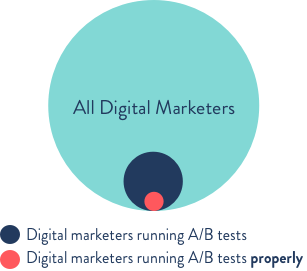The evidence is clear - poorly optimized landing pages are costing businesses money.
For years, we have used landing page testing strategies to improve conversion rates and make more money for our clients without having to increase ad spend. But it was becoming clear that the tools and methods for A/B testing landing pages had not kept up with other AI-driven evolutions in digital marketing.
Until recently.
Last year, Unbounce launched Smart Traffic, an AI-powered optimization tool that "learns about which version of a landing page is most likely to convert different visitors." Rather than split visitors between landing page variants at random (a.k.a. the old fashioned way), the Smart Traffic algorithm routes new visitors to a particular landing page based on their unique attributes. The algorithm gets smarter as you feed it more data which increases the likelihood of converting visitors to leads or sales.
We have been Unbounce customers for over 10 years and tested thousands of landing pages. None of the "industry best practices" or even our own "secret sauce" has come close to creating lifts in conversion rates as consistently as Smart Traffic in our early testing.
Full transparency, I was initially skeptical that an algorithm could beat the old fashioned way. Maybe it was my human pride and overvaluing my own 15 years of experience. But like everything else, we did our due diligence, tested the new tool, and saw consistent improvements in leads and conversion rates for several high-volume clients.
In the example below, an A/B test on this page would take about 3 weeks to reach statistical significance based on the traffic volume, conversion rates, and delta between the two variants. The Smart Traffic algorithm is able to begin optimizing the traffic flow in less than a week and has already squeezed 4.6% more conversions than A/B testing. And this is a modest example. We consistently see 15-30% lifts in total conversion volume with more time and more data.

Success comes to those who learn continuously and remain open to new ideas. Here are three ways for marketers to embrace Smart Traffic and challenge your own assumptions about how landing page testing should be done.
Understand the difference between A/B testing and dynamic traffic allocation
What is A/B testing? At its simplest, it is a test in which two versions of a web page are shown to visitors. Each visitor sees one version or the other. By splitting visitors into two (or more) groups at random, a marketer can compare the difference in conversion rates to determine which page performs better.
Dynamic traffic allocation (called "Smart Traffic" by Unbounce) is a new way of allocating visitors between landing page variants. Instead of splitting visitors at random, Smart Traffic uses a machine learning algorithm to predict which variant is most likely to convert each individual user, in real time. The end result is a higher overall conversion rate for all visitors, not just the ones that happen to land on the "better-performing" variant. After all, a variant that performs better for Visitor A isn't necessarily the best page for Visitor B!
In digital marketing, there is a growing trend towards real-time testing. And for good reason! The ability to discover which landing page variants are most effective for a given situation can help you make immediate changes that affect your bottom line.
However, sometimes marketers have a difficult time letting go of traditional A/B testing.
Re-think A/B testing and be open to new ways of improving your landing pages
A/B testing is one of the pillars of Conversion Rate Optimization and performance marketing. When implemented correctly with a rigorous methodology, A/B testing can lead to huge performance breakthroughs. However, it also has several limitations that cost less sophisticated or time-strapped marketers valuable time and even more valuable conversions:
- It can take a long time to get statistically significant results with traditional A/B testing. The vast majority of brands don't have enough traffic or don't make bold enough changes to their landing pages to see a meaningful change in conversion rates.
- If they aren't carefully monitored, A/B tests can run for too long and result in significant missed opportunities to generate more leads.
- Introducing new variants or changes to existing variants forces a reset of the entire test to get clean, apples-to-apples data.
A/B testing is not a fit for every scenario. Dynamic traffic allocation is a more forgiving iterative approach to testing that is more accessible to more marketers.
Iterative testing sounds backward, doesn't it? Why would anyone want to test something more than once? If a test is successful, you certainly want to review what went right and build it into your future efforts. If a test is a failure, you want to ensure that you don't make the same mistake twice. Sounds nice if you have the time to constantly monitor every single test and turn on/off variants at the exact moment they become statistically valid winners or losers.

Most folks don't have time for that. In fact, most digital marketers don't actively test their campaigns. Of those that do, only a few develop rigorous testing methodologies that increase the likelihood of getting a conclusive result. In other words, there's a huge difference between "A/B testing" and "A/B testing properly."
Smart Traffic requires a different mindset that is less about creating winning variants and casting aside the losers. A "losing" variant could still be the better option for some visitors but an A/B test wouldn't reveal that without a lot of regression analysis. Instead, the Smart Traffic algorithm is constantly testing and optimizing traffic flow in the background.
We know there’s no one-size-fits-all solution for any business, so when it comes to testing, we prefer to make it as foolproof as possible. AI is quickly making that a reality.
Start testing AI & machine learning tools today to be prepared for the future
The reality of today's digital marketing landscape is that marketers need to be nimble, agile and responsive to shifts in consumer expectations. What worked a few short years ago can quickly become outdated or worse, position you at a disadvantage against more advanced competitors.
Machine learning and dynamic traffic allocation helps us scale our efforts and ensures somebody (or something) is always monitoring a landing page test. It's not a marketing panacea and the old adage, "garbage in, garbage out" still applies.
Marketers that are willing to test new methods and challenge their own assumptions will get the best results as we enter a new age of human + computer alliances.
I, for one, welcome our AI overlords...still with a healthy (but not constricting) sense of skepticism.

